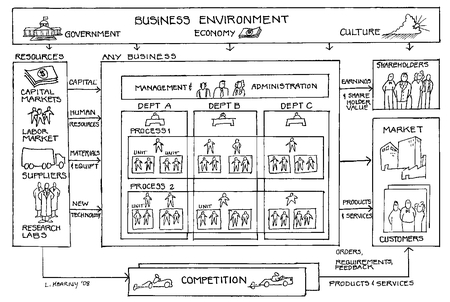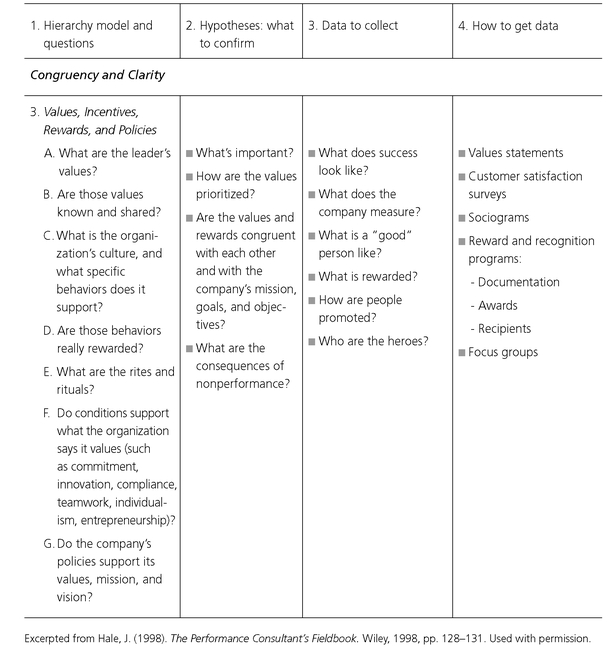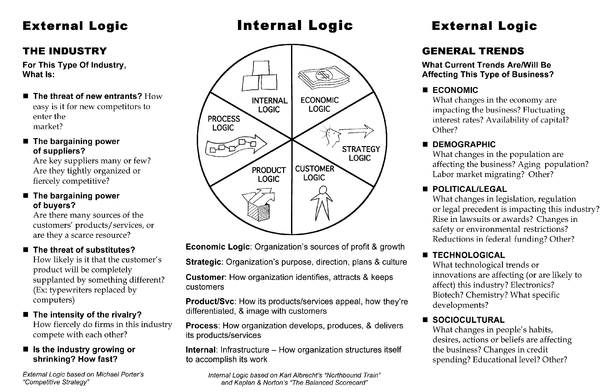APPROACH
Think of yourself as first a detective, and secondly a diplomat. There is some background information you would prefer to find out without asking anyone directly, in order to establish your credibility as a skillful investigator. For information not readily available through preliminary research, you will ask people questions, as courteously and non-disruptively as possible. Assume you will be dealing with both cooperative and uncooperative witnesses. With that mindset, find the answers to the following questions:
• What is the critical business issue?
• What are the internal parts of the organization, and how do they relate to each other?
• What is going on in the organization’s business environment, and how is leadership tracking and responding to it?
Critical Business Issue
“Critical business issues are the threats or opportunities that are most pivotal to the success of the strategy” (Rummler 1995, p. 116). A critical business issue is a business problem, often expressed as a number, stated at a very high level. If it is a critical issue, it is something that threatens the survival of the organization, or something that offers a significant opportunity for growing the business. Typical critical business issues include slipping market share, eroding margins, difficulty sourcing key talent or materials, stock performance, access to new markets.
Most critical business issues are composed of other numbers combined into a single, easy-to-focus-on number like market share or margin. Margin, for example, is income, itself a sum, less cost, which is also a sum of all the expenses of providing the product or service. To improve performance at the Organization Level, identify a critical business issue and use it both to focus your investigation and to frame your recommendations for action. Deconstructing the critical business issue into its component parts can help lead you to where the biggest problems are and provide you with metrics for assessing whether your intervention is working to close the gap.
While you will often be working on a Worker/Individual or Process Level business issue, such as reducing the cost of recruiting and retaining talent, your ability to show how that project affects margin will effectively tie your work to a higher-level critical business issue that senior managers will care about.
Tip: When you work at this level, leadership typically relies on expert consulting resources with wide brand recognition, such as McKinsey or Bain. What experts do the executives in your organization turn to for advice? It may be wise to reference their publications and techniques when making recommendations or proposing a particular approach.
To look at the organization’s internal structure and external realities, performance improvement specialists use environmental and internal scans.
Environmental Scan
Just as we consider the work environment before we can improve an individual’s performance, we consider the organization’s context before we improve its performance. An environmental scan looks at the big environmental factors in the organization’s marketplace. One of several useful models for looking at an organization’s context is Michael Porter’s environmental scan, which looks at both general and industry-specific factors (Porter, 1998).
General Factors or Trends
• Economic
• Demographic
• Political/legal
• Technological
• Socio-cultural
Industry-Specific Factors
• Whether the industry is shrinking or growing
• How intense the rivalry is between competitors
• What the risk is of new competitors entering the industry
• What the risk is of a substitute making the organization’s products and services obsolete, such as
MP3 files supplanting CDs
To understand what is driving strategy and decisions for the organization, the performance improvement practitioner needs the big picture of how the organization fits into its industry. We also need to understand the business environment that has created the risks and opportunities the organization faces. It is useful to create a working summary of our findings so we can validate them, and keep referring to them as we work.
Internal Scan
In Chapter 2, The Worker: Individual/Team Level, we emphasize the need for goals and expectations. The same is true at the Organization Level: to assess current performance and target improvements, it is important to know the mission, goals, targets, plans, and strategies in place for reaching the goals.
Performance improvement specialists also map the structure of the organization—not merely with an organization chart, but with a diagram that shows the major divisions of the organization, such as research and development, manufacturing, and sales, and how they relate to each other. A truly useful map will also show key cross-functional processes and feedback loops.
What are the current challenges, obstacles, and limitations facing the organization? A challenge might be that a significant competitor is bringing products to market faster and at a lower cost. Obstacles could include a shortage of investment capital for expanding a key manufacturing line. A limitation might be stringent environmental regulation in states where the company operates. Create a map or summary of what you learn as an ongoing reference for your work. The section on mapping the organization that follows shows a sample map.
Link to Critical Business Issues
Organization level analyses and solutions must address critical business issues that affect the welfare of the whole organization, like losing market share, missing profit targets, increasing costs, flat revenues, lower pricing from the competition’s superior products/services, lower earnings, missed sales targets, or large numbers of unhappy customers (lawsuits, complaints, departures). Other critical business issues include failing a key general audit or incurring regulatory penalties.
Major opportunities and initiatives are also critical business issues. These may be strategic-level, organization-wide initiatives, like a change in market focus, or customer strategy, such as the launch of a “customer-first” initiative. Perhaps a new core product or process is being introduced, like implementing electronic medical records for a large health-care system or an expansion from an international to a multi-national organization.
Often, clients ask for a solution without specifying the business issue. You may have to be persistent to uncover it, but an issue is always there. Identifying the issue and being able to articulate it clearly is key because the issue is both the target and the engine that will power your project.
Preliminary Research
Here are some things to find out about the organization before launching an Organization Level project.
• Check the company’s stock price and current news releases for initial context information.
• Make a friend in finance, as we suggest in Chapter 2, The Worker: Individual/Team Level, and ask:
• What are the important numbers this year, this quarter . . . and how are we doing?
• What non-financial numbers are part of this year’s goals and tracking (market, customer, product/service, process-related)? How are we doing?
• Given the performance improvement issue(s) you are pursuing, what is the impact on key business metrics for the organization?
• What are the management practices/culture? This means, irrespective of what management says, how they actually operate day-to-day.
• What behaviors and accomplishments are rewarded, and which are punished?
• What does or does not fit with “the way we do things around here”?
Organizational Politics
It is not enough to have a good technical plan; you also need a good political plan if you want to get anything done. Politics in organizations is the source of much confusion and angst: it is also the source of power and influence. Politics comes from the Greek word for people, and has the same root as policy. If you have more than two people in a room, you will have politics.
Politics is the process of influencing others to make decisions, support ideas, and advance goals. It is how we really get things done, and is the glue behind the organization chart. The important things to recognize about organizational politics are:
• They are there, they are necessary, and they will never go away
• We need to understand and work with them to accomplish anything in an organization
• If we attempt to ignore or avoid them, we disenfranchise ourselves and doom our projects to failure
In our view, there are two positions people play in organizational politics: destructive and constructive.
Destructive Politics. By destructive politics, we mean people who influence others only to advance their own personal goals and who subordinate everything else to their own interests. This may involve lying, cheating, and undermining others, and it’s the reason politics gets a bad name. We believe it is a big mistake to engage in destructive politics, but it would be foolish to claim that it doesn’t exist, or that it isn’t sometimes successful.
Constructive Politics. By constructive politics, we mean influencing others for the advancement of organizational goals and serving the long-term interests of all. It is our experience that constructive politics is necessary to influence people to change, which is, after all, the objective of improving performance. Sometimes using constructive politics doesn’t prevail, but the better you get at it, the more projects you will bring to successful completion.
So how do you succeed at constructive politics? First, it’s important to understand where you are positioned in the political landscape. In the organization, or in the part of it you are dealing with, who has power? That power may be formal, due to the person’s position, or informal, due to factors such as expertise, personality, reputation, or a strong ability to form alliances. What relationships, both personal and professional, and alliances do those with power have? Who are the decision-makers in the organization, and who are the influencers and advisors they rely on to inform them before they make decisions? The decision-makers are often obvious from the organization chart, but their influencers and advisors are not. We typically uncover this information by asking people, and by observing interactions among members of the organization. Internal consultants have an advantage here—they often already know, or know whom to ask, as may your clients.
Second, identify the political stance of the people with power who are likely to be involved in the change you want to make:
• Spectator—an observer
• Win-Lose Player—a key person who uses destructive political power
• Constructive Player—a savvy person who likely has both personal and position power
This is an important activity because it will enable you to know what kind of responses to expect, and who to work with versus who to work around. You don’t want to put a spectator in a key role in an implementation plan, for example. One of us had the unhappy experience of implementing a cross-functional initiative with a win-lose player in a key liaison role. This can’t always be avoided, but you want to know what to watch out for and what to lobby for. And while you are evaluating the political positions of key people, what is your own?
Third, develop your influence strategy. This includes both communication and coalition building. Savvy performance consultants plan who to talk to and in what order to gain the ear of those whose cooperation is critical. This technique is referred to later in this chapter as “divide and conquer.” If the people you need to influence don’t share the same goals, look for a way to bring them together to create a coalition. A good start is to use one-on-one meetings to try out ideas on an individual, and ask, “What do you think?” “Why do you think that?” “What is your position?” and “How do you feel about X point of view?” Once you understand that one key person is really concerned about customer service and another cares about reducing turnaround time, you can pull together a solution that addresses both concerns, and build a coalition of support for your project (B. Lawton, personal communication, July 2008).
Political Mistakes to Avoid
• Don’t be a purist. Many projects fail because the person driving them sacrificed the good for the perfect, and nothing was implemented.
• Don’t act as if you know all the answers and are there to straighten everyone else out. Show respect for the culture and environment of your client, and for their understanding of the situation. Carefully approach your “truth” bit by bit.
(B. Lawton, personal communication, July 2008)
Political Opportunities to Seek Out
• External consultants are like tourists. As long as they respect the local customs and look more than they talk, they have license to be a little strange and say things that internal people couldn’t get away with. We find that partnering with internal consultants can help the externals be more effective while smoothing their way.
• Internal consultants are like native guides. They understand the culture and customs and can offer good advice about who to approach and how to do it. All the authors have at one time been internal consultants. We found that partnering with external consultants helped us deliver messages that would not have been heard had we delivered them ourselves.
Map the Organization to “See” Context. Earlier, we discussed the need for creating a map of the organization’s context: its environment and its functions. There are a number of good models for creating your map. Here are four of them. Each will give you a different perspective on the organization. All are very useful.
Geary Rummler’s Organization Maps. The Anatomy of Performance is a map of the organization and its super-system (Rummler, 1995). Figure 4.1 shows the organization and its relationships with suppliers, markets, competition, and the economic, regulatory, and business environment. The external part of the super-system includes government/regulation, the economy, and society, the market, the competition, and resources such as capital, labor, suppliers, and expertise. The internal part of the super-system shows the organization’s key processes as well as interactions among departments. This will help you, and often your client, see all the elements of a dynamic system that has a powerful influence over everything that happens within the organization, and assess how the elements impact the business issues you are trying to address.
FIGURE 4.1. Anatomy of Performance.
Source: ©2008 Geary Rummler and the Performance Design Lab. Used with permission.

Figure 4.2 is another way to view the Anatomy of Performance.
FIGURE 4.2. Anatomy of Performance Graphic.

Judith Hale’s Performance Consulting Job Aids. We have found Hale’s Hierarchy Job Aid an excellent tool for doing a high-level assessment of how well an organization is functioning as a whole (Hale, 1998, pp. 128-131). It works as well with governmental and not-for-profit organizations, as with corporate clients. Table 4.1 shows only the first portion, which addresses congruence and clarity—what we call alignment in the rest of this chapter. The job aid includes:
• A model for reviewing the entire organization
• Questions to find answers for
• Hypotheses to confirm
• Data to collect and how to get them
The model covers:
• Vision and Mission
• Goals and Objectives
• Values, Incentives, Rewards, and Policies
• Efficiency
In addition, the job aid lists a half dozen other useful areas to investigate. Together the model and the job aid help to assess whether the organization currently has the capacity to achieve its goals, and if it does not, how to build capacity so the goals can be reached.
TABLE 4.1. The Hierarchy Job Aid.


The Balanced Scorecard Job Aid (Hale, 1998, p. 120) is helpful for targeting key business issues at the Organization Level, scoping the problem, and guiding a client to prioritize where to invest limited resources. It also provides good data for measuring the results of a performance improvement project.
Business Logic Analysis. The model in Figure 4.3 shows an external scan with general trends, industry trends, key threats and opportunities, and an internal scan with finance, strategy, customer, product, process, and infrastructure (Kearny & Silber, 2006). It will give you a clear understanding of what the business is trying to do and show how to find the metrics the organization uses to assess how well it’s doing. You can obtain the full job aid on the web at www.silberperformance.com under Presentations.
FIGURE 4.3. Business Logic Model.

..................Content has been hidden....................
You can't read the all page of ebook, please click here login for view all page.
